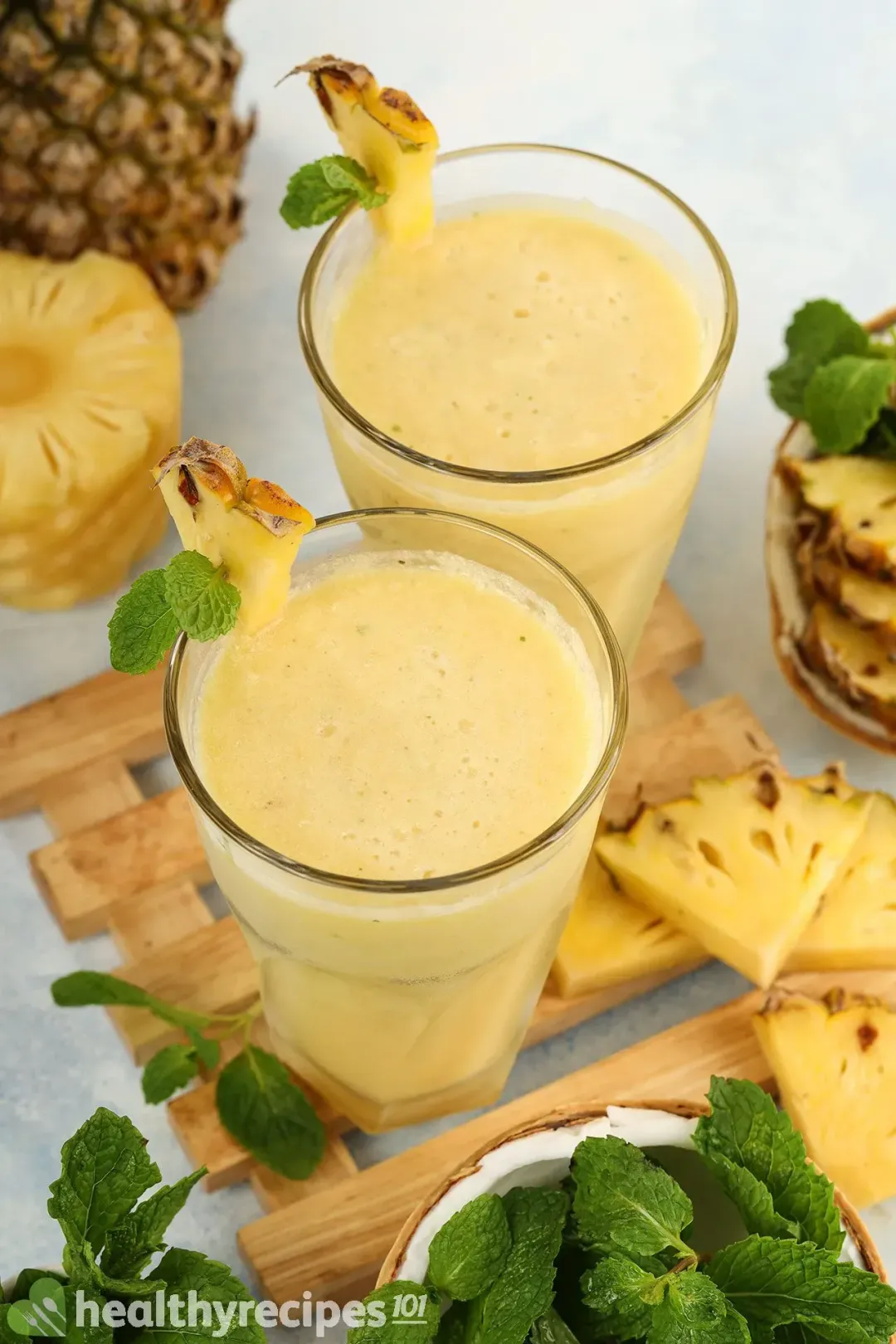This pineapple coconut smoothie recipe combines two tropical fruits to make a creamy, sweet, fresh summer beverage.
Is Pineapple Coconut Smoothie Healthy?
Yes, we believe it is.
Pineapples are high in vitamin C and manganese while containing a variety of other nutrients such as B vitamins, copper, potassium, magnesium, and more.
Our smoothie uses both coconut water and coconut milk. They have trace amounts of minerals such as manganese, copper, selenium, phosphorus, calcium, iron, and so on.
Blended together, they provide you with a vast array of nutrients in varying amounts.
Coconuts are also high in saturated fats. To keep these fats at an acceptable level in our smoothie, we had to adjust the portion size. This also lowers the calories to 110 per serving, about 5.5% of a 2000-calorie diet.

Smoothies often have added sugar, which, like calories and saturated fats, should be regulated. However, if your pineapples are sweet enough you won’t need to add any.
If you do need to sweeten your smoothie, be mindful of how much added sugar you consume that day. The maximum recommendation of added sugar for a 2000-calorie diet is 50 g, so we suggest no more than 1 tbsp of honey a serving — 34% the recommended amount.
For more nourishing, delicious smoothies featuring these fruits, check out our Coconut Smoothie, Mango Pineapple Banana Smoothie, Pineapple Strawberry Banana Smoothie, and Pineapple Blueberry Smoothie.
Main Ingredients
To follow our pineapple coconut smoothie recipe you’ll need: pineapples, coconut milk, coconut water, ice, and mint leaves.
1. Pineapples
With no sweetener in this recipe, it’s important that you use a ripe, sweet pineapple for your smoothie. There are a few ways to tell a ripe pineapple from the others:
- Sniff the bottom of the fruit. A ripe pineapple should emit a flowery, sweet aroma.
- Squeeze the fruit. A ripe pineapple should give a little.
Some pineapples can be overly ripe, having fermented a little, giving off an alcohol-like fragrance. Overripe pineapples are safe to eat unless they are rotting.
2. Coconut Water
Coconuts can be difficult to work with, so we used canned products.
You can easily find canned or bottled coconut water in most grocery stores. A small warning, though: be sure to pick unsweetened products, or pineapple coconut smoothie will be overly sweet.

3. Coconut Milk
There is quite a difference in consistency between various coconut milk products:
- Fresh coconut milk is quite thin, like regular milk.
- Coconut-flavored drinks are as thin as coconut milk but the content may not be pure coconut milk.
- Canned coconut milk (sometimes called coconut cream) is thick and has a higher fat content than fresh coconut milk. This is the product we use.
To tell canned coconut milk (or coconut cream) apart, be sure to look at its ingredients. Our product lists 60% coconut extract and 40% water, and of course, no added sugars.
Coconut milk also comes in powdered form, which we recommend for cooking only.
3. Ice
If your blender has a strong motor, the type of ice you use shouldn’t matter. Otherwise, you may want to choose ice nuggets or soft ice.
In the case of the average blender, using hard ice, like crescent ice, requires you to break it into finer pieces first so your blender can handle it. Place the ice in a cloth, put it on the counter, and pound it with something heavy, like a pestle or rolling pin.
4. Mint
Several mint leaves add a nice cooling sensation to this tropical smoothie.
How to Store Coconut Milk
Coconut milk placed in an air-tight container can be refrigerated for about 10 days. Canned coconut milk can be wrapped with plastic wrap and refrigerated for the same amount of time.
However, there is still a risk of this product spoiling prematurely.

How to Tell If Coconut Milk Has Gone Bad
Notice these signs and toss the spoiled coconut milk in the trash:
- A tart, unpleasant smell.
- A film of mold floating atop the product. This film is often white, so it’s important to inspect it closely.
Like most plant-based dairy alternatives, coconut milk shouldn’t be stored in the freezer, as it may result in a significant reduction of quality.
How Long Does It Last?
Keep this smoothie in the fridge for a maximum of 2 days. Place it in air-tight containers or wrap it’s container in plastic wrap before storage.
Pineapple Coconut Smoothie Recipe
Our pineapple coconut smoothie recipe takes just 7 minutes to turn out a delicious beverage rich in both textures and flavors.
- prep TIME 7 mins
- total TIME 7 mins
- COURSE Beverage, Smoothie
- CUISINE Global
- SERVINGS servings
- CALORIES 110 kcal
INGREDIENTS
- 20 oz pineapples (cut into chunks)
- 2 cups ice
- 1 cup coconut water
- 1/4 cup coconut milk
- 8 mint leaves
INSTRUCTIONS
Place all ingredients: 2 cups ice, 20 oz pineapples, 1 cup coconut water, 1/4 cup coconut milk in a blender, starting with the ice.

Cover and blend in 30 seconds to 1 minute until smooth.

Garnish with fresh mint leaves and serve immediately.

NUTRITION
Tuyet Pham
Head Chef, Culinary ConsultantLuna Regina
Writer, AuthorSaVanna Shoemaker, MS, RDN, LD
Nutrition Reviewer
- Abby ClaboughThis smoothie is a refreshing and tropical drink that's perfect for a hot summer day.


